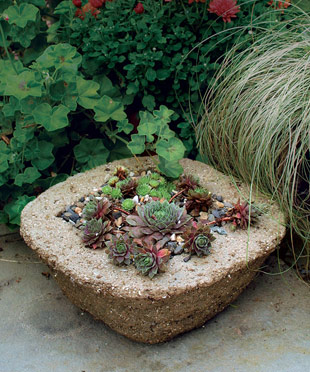I thing everyone had a mudpie experience as a child. The technique of making hypertufa will stir your memories of this experience or be a great project to do with your children’s or grandchildren’s help.
For those who are not familiar, hypertufa is a man-made substitute for natural tufa (a slowly precipitated limestone rock). As it is very porous, it is favorable for plant growth.
With hypertufa, you can release your inner sculptor and create garden ornaments, pots, troughs, mimic alpine garden worn stone… it is limited only by your artistic sense! As added benefits, it is lighter than concrete and able to withstand harsh winters (at least down to -30 °C (−22 °F). I was at a garden show demo a number of years back and have been meaning to try this. Today, I came across a great article from Fine Gardening complete with recipe and instructions.
Containers made from hypertufa are wonderful for displaying rock-garden plants or succulents. Over time, the hypertufa ages gracefully, collecting a patina of mosses and lichens. In this article you will find the recipe and instructions for making hypertufa.
The process I use to mold containers is much simpler that the usual box-in-box method that sandwiches hypertufa and some metal mesh in a frame. Instead, I simply pack hypertufa around an overturned plastic pot or planter. And because it’s so easy to work with, hypertufa can be molded into many sizes and shapes.
Read the original Fine Gardening article and full recipe here…
Don’t forget to share pictures of your projects. We would love to share!


How do you embed tiles or stones into a hypertufa project? Also, I noticed that in your pictured hypertufa pot, the sides hang over. How did you do that?
Thanks for your help.
Maria Schopen
Hello Maria and thank you for your question. Our blog post just scratched the surface of the making of a hypertufa pot. Please follow the link to Fine Gardening article and full recipe here… https://www.finegardening.com/design/articles/make-your-own-container.aspx
Good luck with your project!